

Rick Maze, Congressional Editor, Navy Times

Jim Holley, Public Affairs Officer, House Committee on Veterans’ Affairs

Honorable George H.W. Bush, 41st President of the United States

General Norman Schwarzkopf, U.S. Army

Honorable Bill Clinton, 42nd President of the United States

General John Shalikashvili, Chairman, Joint Chiefs of Staff

Philip Odeen, Chairman, National Defense Panel

Anthony Principi, Chairman, Congressional Commission on Service Members and Veterans Transition Assistance

Honorable Gary Hart, Co-Chairman, U.S. Commission on National Security/21st Century

Vice Admiral Patricia Tracey, Deputy Assistant Secretary of Defense

Representative Christopher H. Smith (R-NJ), Chairman, Committee on Veterans’ Affairs

Representative Lane Evans (D-IL), Ranking Democratic Member, Committee on Veterans’ Affairs

Colonel Bob Norton, U.S. Army (Ret), Deputy Director of Government Relations, Military Officers Association of America

Nancy Gibbs, TIME Magazine

Ed Elmendorf, Vice President, American Assn. of State Colleges and Universities

Mike McGrevey, former Vice President, Mississippi State University
SONNY’S SUMMARY
Surveys consistently show the Montgomery GI Bill is the primary incentive to which military enlistees respond and that we continue to recruit youth of uniformly high quality. National study group reports of 1997, 1999, and 2001 all warned of the need for a strong military to protect the United States from attacks by rogue nations and international terrorist groups and the continued need for recruiting high-quality youth into our military.
Through legislation primarily sponsored by Representative Chris Smith (R-NJ) and Senators Arlen Specter (R-PA) and “Jay” Rockefeller (D-WV), President George W. Bush signed H.R. 1291, the Veterans Education and Benefits Expansion Act of 2001, into law, including a record 46-percent increase in the Montgomery GI Bill over three years. House Budget Committee Chairman Jim Nussle (R-IA) and Ranking Member John Spratt (D-SC) authored some $7 billion in direct-spending increases for this bill in the Congressionally approved FY 2002 Budget Resolution.
In addition, from 2002 to 2004 alone, Congress made six major eligibility enhancements to the Montgomery GI Bill.
Lastly, in 2008, Senators Jim Webb (D-VA) and Chuck Hagel (R-NE) primarily authored legislation enacted into law that enhanced the Montgomery GI Bill’s purchasing power; and created a more generous “Post 9-11 GI Bill” for enlistees that included two original provisions from H.R. 1400, the proposed Veterans’ Educational Assistance Act of 1981.
Mr. Montgomery
Folks, the first three years of Montgomery GI Bill implementation saw continued enthusiasm for it as evidenced by high sign-up rates, including enlistees who scored in the upper quartiles on the Armed Forces Qualification Test.
I was pleased the program was working, as these service members would soon be asked to appear on the world stage, indeed a dangerous place.
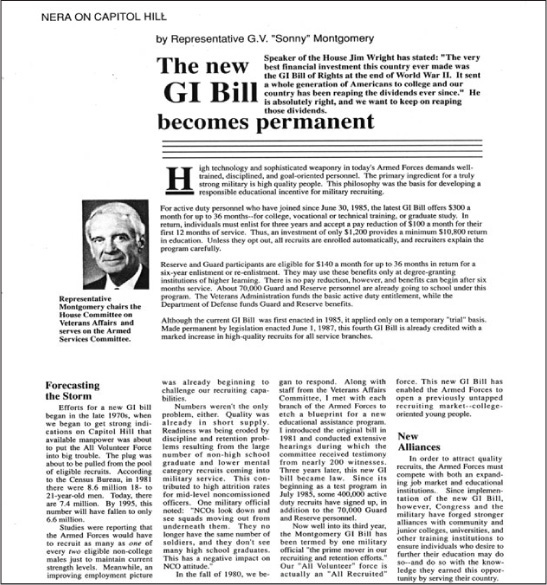
Article by Sonny in “The Mariner,” Jan./Feb. 1998, page 10, a publication of the Naval Enlisted Reserve Association.
The year 1988 was important because it was the first year of implementing the permanent New GI Bill program—now by law called the Montgomery GI Bill. Here are some excerpts from an article I wrote for the January/February edition of The Mariner, the magazine of the Naval Enlisted Reserve Association:1
“Since its beginning as a test program in July 1985, some 400,000 active duty recruits have signed up, in addition to 70,000 Guard and Reserve personnel… Our ‘All-Volunteer’ Force is actually an ‘all-recruited’ force. This New GI Bill has enabled the Armed Forces to open a previously untapped recruiting market—college-oriented young people…
“… In FY 1980, before implementation of the Montgomery GI Bill, 52 percent of the Army’s non-prior service accessions were in the lowest mental category (IV). Contrast this with the four percent [emphasis in original] Category IVs being accessed during FY 1986. The number of high school graduate recruits increased from 54 to 91 percent during the same period. In addition, the percentage of higher mental category recruits grew from 26 to 63 percent.”
Mr. Rick Maze wrote about the implementation of the Montgomery GI Bill in the March 21, 1988, edition of the Navy Times:2
Mr. Maze
“The [Montgomery] GI Bill is giving the services people who might not otherwise have enlisted. ‘I was going to try to save money for college anyway,’ Army recruit Barbara Huntley of Toledo, Ohio, said, ‘The GI Bill seemed to be a good way to do it.’”

Rick Maze
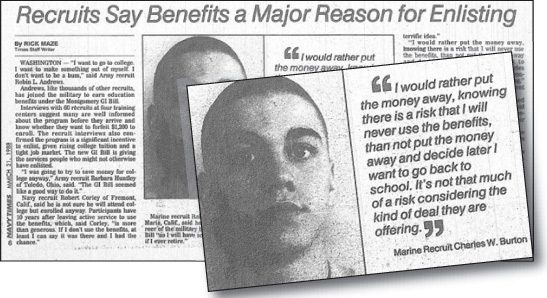
Excerpt from Navy Times, March 21, 1988.
On June 30, 1988, Mr. Jim Holley, Public Affairs Officer for the House Committee on Veterans’ Affairs, which I chaired and on which Representative Jerry Solomon (R-NY) served as ranking member, issued a news release. The release commemorated the third anniversary of the New GI Bill, now called the Montgomery GI Bill:3
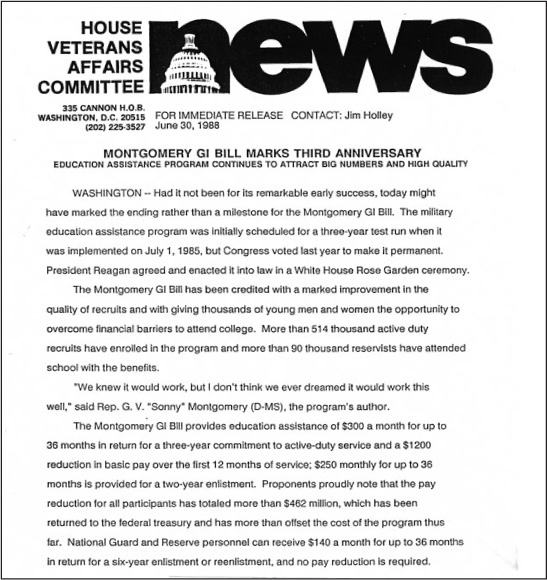
Press release issued by House Committee on Veterans’ Affairs June 30, 1988.
Mr. Holley

Jim Holley
“Had it not been for its remarkable early success, today might have marked the ending rather than a milestone for the Montgomery GI Bill. The military education assistance program was initially scheduled for a three-year test run when it was implemented on July 1, 1985, but Congress voted last year to make it permanent.
“The Montgomery GI Bill has been credited with a marked improvement in the quality of recruits and with giving thousands of young men and women the opportunity to overcome financial barriers to attend college.
More than 514,000 active duty recruits have enrolled in the program and more than 90,000 Reservists have attended school with the benefits…. Proponents proudly note that the pay reduction for all participants has totaled more than $462 million, which has been returned to the federal treasury and has more than offset the cost of the program thus far.”
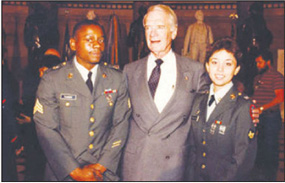
At signing of Montgomery GI Bill in Statuary Hall, Sonny poses with two U.S. Army soldiers.
Mr. Montgomery
June 5, 1990, was a wonderful day. President George H.W. Bush held a ceremony honoring the original GI Bill, as well as the one millionth service member to sign up for the Montgomery GI Bill. Noted the President:4”
In October, 1945, Barbara and I joined the ranks of more than 40,000 couples who headed to college that year on the original GI Bill. America’s schools were soon swamped with prefab housing and trailers. And by 1946 and 1947, the flood tide had crested, and more than 2.5 million veterans had embarked on getting their education.
“… The GI Bill changed the lives of millions by replacing old roadblocks with paths of opportunity. And in so doing it boosted America’s work force, it boosted America’s economy, and really, it changed the life of our nation.
“… And I remember some of the tough battles that were fought to get the new bill through Congress. Sonny interrupted one marathon conference session with a rather unique reminder of the needs of the military and of his own commitment to stick it out. He brought in C-rations, and eating them on the Hill is my definition of serious commitment.
“… Today, the Montgomery GI bill ranks among the most practical and cost-efficient programs ever devised….”
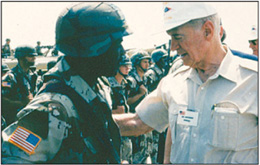
Sonny visits soldiers during the Persian Gulf War in 1991.
I’d like to share with you three important events that created the New GI Bill, a bill I did not anticipate would include my name in its title.
First, during the Persian Gulf War in 1991,5 I felt honored to go to Kuwait to talk with the many high-quality American soldiers, sailors, airmen, Marines, and Coast Guardsmen of “Operation Desert Storm,” who put their lives on the line to liberate that sovereign nation from the occupation by Iraq.
About 95 percent of these soldiers signed up for the Montgomery GI Bill6 when entering the military; that made my colleagues and me happy!
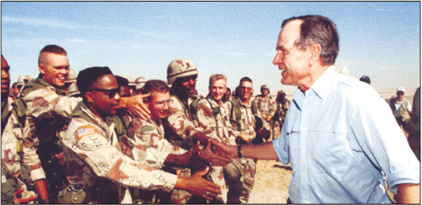
President George H.W. Bush and troops during Persian Gulf War.
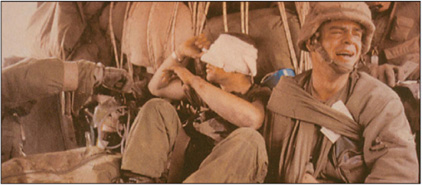
The soldier weeps not for himself.

A daughter reunites with her mother who was captured and taken prisoner by Saddam’s Hussein’s Iraqi Army.


First Lady Barbara Bush (center), President Bush, and General Norman Schwarzkopf.
Second, our nation’s capital paused to say thanks to the men and women of our country’s military, teamed with some 26 coalition countries—including a half-dozen Arab countries—who served during the 1991 Operation Desert Storm to defend Kuwait’s sovereignty.7
Noted General Norman Schwarzkopf later:

The Montgomery GI Bill helped bring a new day to the All-Volunteer Force.
Gen. Schwarzkopf
“It doesn’t take a hero to order men into battle. It takes a hero to be one of those men who goes into battle.”8
Scenes from the 1991 Desert Storm victory parade in Washington, D.C.



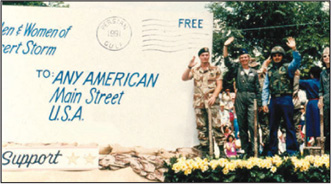

Mr. Montgomery
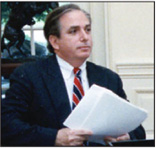
Richard Darman
And third, an interesting experience I had when I left the House floor to take a telephone call from Richard Darman, Director of OMB in the George H.W. Bush White House.
I am pretty sure it was 1992. But I don’t think the year is as important as the lesson in communication that Director Darman conveyed.9
I was on the House floor with other members who had helped enact the Montgomery GI Bill into law. The House was considering legislation to increase the monthly educational assistance allowance under the Montgomery GI Bill from $350 to $400 per month, as I recall.
I was waiting to ask the House to consider the bill when I was told that OMB Director Darman had telephoned me and was on hold on the phone in the cloak room. So I immediately went to the cloak room and we chatted for five minutes or so.
As I recall, Director Darman said the Administration would support the bill under consideration. But Mr. Darman asked my help in keeping the entitlement cost of the MGIB increase to a figure, I think, of about $200 million.
As I remember it, Director Darman was focusing not so much on the bill we’d pass that day in the House but the cost of the MGIB increase when it came out of conference committee with the Senate.
I believe the Administration wanted to limit the increase to the cost of inflation, as personnel costs, for example, were already more than 50 percent of the DoD budget.10 I believe I said to Director Darman I especially appreciated his thoughtfulness in personally calling me—and that I’d earnestly consider his request on behalf of the Administration.
I was Democratic Floor Manager for the bill. So, when I got back to my seat in the House chamber, my Committee Chief Counsel Mack Fleming and Deputy Chief Counsel Patrick Ryan asked me the time period over which Director Darman asked Congress to limit the cost.
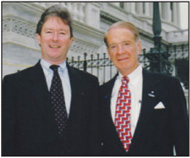
Patrick Ryan and Sonny.
For example, both the OMB and the Congressional Budget Office project costs of entitlement legislation over one, five and ten years. I said to Mack and Patrick I didn’t recall Director Darman specifying a number of years, although he may have done so. Mack and Patrick immediately assumed it was five years, since that was the usual time frame used for cost estimates.
As I remember it, in the House-Senate conference version of the bill, Congress increased the MGIB by $50 in 1992,11 so as to spend the $200 million in two years rather than in five or ten years, for example. If we had spread the $200 million in smaller MGIB increases over ten years, it would have had a much more diluted effect, as a financial-aid tool for the veteran student.
I’m not sure our approach was what Director Darman had in mind on a specific cost figure. But I’m not sure either I could have won support from House members by doing it any other way than the way in which the House and Senate ultimately enacted it.
Folks, I share this anecdote with you because it represents some of the reality of lawmaking; the reality of a director, OMB, and a chairman of a committee essentially discussing and negotiating a bill—person to person—while it’s under consideration on the House floor.
Direct, informal discussion of this type between the Executive and Legislative Branches represents an effective way to do business, in my view. It cannot happen in every instance; and it may not be something you’ll read about in other text books. But it works.
In any case, I appreciated Mr. Darman’s forthright and thoughtful communication, as well as his personal involvement. Mr. Darman had a much bigger job than I did. My colleagues and I tried to look after the interests of America’s sons and daughters who served in our military in their transition to our civilian economy. Director Darman had to focus on the entire breadth of the United States budget and the nation’s vital economic health.
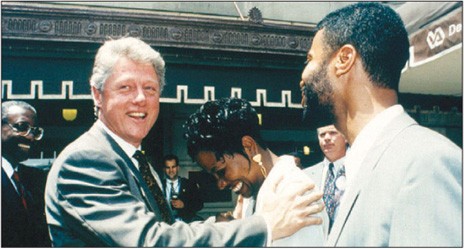
President Bill Clinton greets VA employees at the 50th anniversary celebration of the WW II GI Bill.
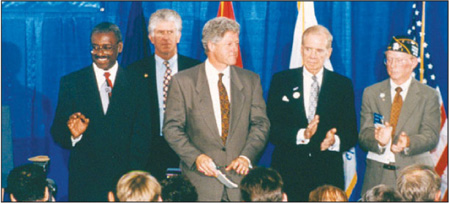
At the celebration, from left, Secretary of Veterans Affairs Jesse Brown, Secret Service agent, President Clinton, Sonny and Garnett Shropshire of the American Legion.
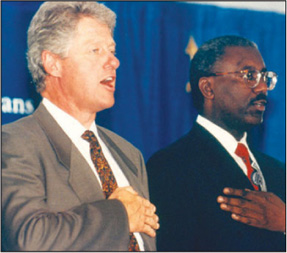
President Clinton and Sec. Brown.

The posting of the colors was a vivid reminder of the men and women who serve.
In June 1994, President Bill Clinton walked from the White House across Lafayette Park to the Department of Veterans Affairs to personally lead a 50th anniversary celebration of the World War II GI Bill.12
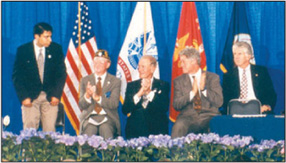
Army Specialist Mendoza, left, represented Desert Storm veterans.
I’m grateful the President invited me to the occasion.
Secretary of Veterans Affairs Jesse Brown introduced Army Specialist Hugo Mendoza, who represented Desert Storm veterans at the celebration. What an honor to be in Specialist Mendoza’s presence. Secretary Brown was wounded in combat while serving with the U.S. Marine Corps in Vietnam in 1965. He was unable to raise his right arm for the remainder of his life.13
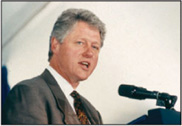
Said the President…
President Clinton
“Just as D-Day was the greatest military action in our history, so the GI Bill was arguably the greatest investment in our people in American history.14
“The veterans of World War I… got $60 and a train ticket home. The veterans of World War II got a ticket to the American dream.”15
Mr. Montgomery
Have you heard the term “budget reconciliation?”
In effect, it means that periodically Congress tries to bring federal revenues and spending into line to save money and reduce the federal budget deficit. A more formal definition appears on the U.S. Senate web site:16
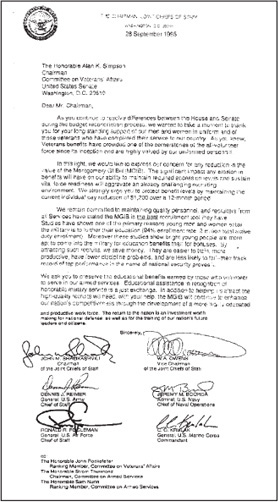
Letter from the Joint Chiefs.
“[Budget] reconciliation is a process established in the Congressional Budget Act of 1974 by which Congress changes existing laws to conform tax and spending levels to the levels set in a budget resolution. Changes that are recommended by committees pursuant to a reconciliation instruction are incorporated into a reconciliation measure.”
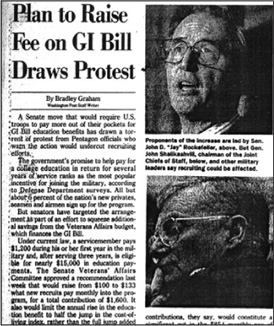
From the Washington Post, Sept. 29, 1995.
Based on guidance from the Budget Committee, each committee involved has to introduce and mark-up legislation adjusting revenues or spending in their area(s) of jurisdiction.
For example, a proposal under consideration in 1995 would have increased the $1,200 pay reduction service members pay to be eligible for the Montgomery GI Bill. In this regard, General John Shalikashvili, chairman of the Joint Chiefs of Staff, will speak to his letter of September 28, 1995,17 to Senator Alan Simpson, chairman, Committee on Veterans’ Affairs.
Cosigning the letter were the Vice Chairman of the Joint Chiefs; the Chiefs of Staff of the Army and Air Force; the Chief of Naval Operations; and the Commandant of the Marine Corps.
Although he initially opposed what became known as the Montgomery GI Bill in 1987, Mr. Simpson was one of the first Senators to suggest (some say acknowledge) that the VA—instead of the Department of Defense—would have to fund it. He prevailed! VA funded it because the GI Bill fundamentally is a tool for transitioning from military to civilian life.18
As far as I know, Mr. Simpson personally proposed no such cuts in the Montgomery GI Bill under reconciliation.19 The chiefs wanted to ensure that rank-and-file members of the committee knew their views on possible increases in the $1,200 pay reduction required to be eligible for the Montgomery GI Bill.
Gen. Shalikashvili

Gen. John Shalikashvili
“Mr. Chairman, I’ll simply highlight a few lines from our 1995 letter to Chairman Simpson:
“As you know, veterans’ benefits have provided one of the cornerstones of the All-Volunteer Force20 since its inception and are highly valued by our uniformed personnel.
“In this light, we would like to express our concern for any reduction in the value of the Montgomery GI Bill.
“The significant impact any erosion in benefits will have on our ability to maintain required accession levels and sustain vital force readiness will aggravate an already challenging recruiting environment.
“We strongly urge you to protect benefit levels by maintaining the current individual pay reduction of $1,200 over a 12-month period [and not increasing it under reconciliation].
“In addition to helping us attract the high-quality recruits we need, with your help, the Montgomery GI Bill will continue to enhance our nation’s competitiveness through the development of a more highly educated and productive workforce.
“The return to our nation is an investment worth making for national defense, as well as for the training of our nation’s future leaders and citizens.”
Mr. Montgomery
Ultimately, Congress found other reductions in veterans’ benefits to meet the reconciliation requirement.21 Enough said!
Fast-forwarding in time shows an increasingly dangerous world, including attacks by terrorist groups over the years on:
• The passenger ship Achille Lauro, 1985;
• Pan Am Flight 193 over Lockerbie, Scotland, 1988;
• The World Trade Center, 1993;
• U.S. embassies in Kenya and Tanzania, Africa, 1993;
• U.S. military personnel at the Khobar Towers housing complex in Saudi Arabia, 1996;
• U.S. Navy ship, USS Cole, 2000; and
• The World Trade Center and the Pentagon, 2001.
Each attack showed how terrorist cells can hurt Americans.
These security vulnerabilities led to compelling reports of expert United States commissions in 1997, 1999, and 2001.
These reports—plus the expert legislative testimony of Vice Admiral Patricia Tracey before the House Veterans’ Affairs Committee in 2000—served to shape significant enhancements to the Montgomery GI Bill from 2000 to 2004.
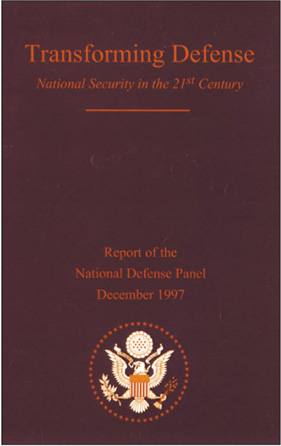
Odeen Panel Report
Each report spoke to the possibility of terrorist attacks within our own borders and the need to recruit quality people to defend us at home.
We, as a nation, would not now only ask civilian police, fire, emergency services, and other first responders to do the job of keeping our cities and communities safe by themselves. We’d ask for our military to play a defined role, as well.
Let’s hear from Philip Odeen, chairman of the National Defense Panel. The Panel issued the 1997 report to Secretary of Defense Bill Cohen, Transforming Defense: National Security in the 21st Century:22
Mr. Odeen

Philip Odeen
‘‘We must never forget that our people in uniform have been the core of our strength in the past. They, more than any hardware system, form the real defense capability of today and tomorrow.
“Our report also quoted the warnings of Secretary Cohen himself. Here are the Secretary’s 1997 words:23
“‘As the new millennium approaches, we face the very real and increasing prospect that regional aggressors, third-rate armies, terrorist groups, and even religious cults will seek to wield disproportionate power by acquiring and using these weapons that can produce mass casualties. These are neither farfetched nor far-off threats.’”
[The Transforming Defense report also noted:]
“‘We can assume that our enemies and future adversaries have learned from the Gulf War. They are unlikely [emphasis added] to confront us conventionally… instead they may find new ways to attack our interests, our forces, and our citizens.’”24
Mr. Montgomery
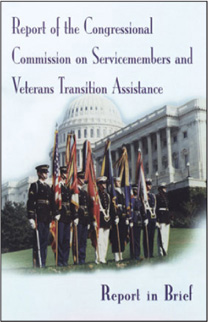
The 1999 report of the bipartisan Congressional Commission on Service Members and Veterans Transition Assistance examined the federal benefits our military earns for its service.25
Here’s Commission Chairman Anthony Principi. Mr. Principi went on to serve with distinction for four years as President George W. Bush’s Secretary of Veterans Affairs and later headed the 2005 [Department of Defense] Base Closure and Realignment Commission:26
Mr. Principi

Anthony Principi
“To defend the country in the 21st century, the Armed Forces must recruit high-quality high school graduates of college caliber. The chief vehicle for accomplishing these goals is the Montgomery GI Bill, a direct descendent of the great World War II GI Bill that helped transform the nation….
“In enacting the Montgomery GI Bill, a farsighted Congress under the inspired leadership of veterans’ champions like Congressman G.V. ‘Sonny’ Montgomery, severed the link between [strictly] wartime service and education benefits….
“However, most college-bound youth and their families see a tour of military service as a detour from their college plans, not as a way to achieve that goal….
“The commission believes the Montgomery GI Bill represents an untapped opportunity for the nation. An enhanced Montgomery GI Bill that would pay for tuition, books, fees, and a monthly subsistence allowance would differentiate, on the basis of quality of education, the educational assistance benefits earned through military service from benefits available to the general public.”
Mr. Montgomery
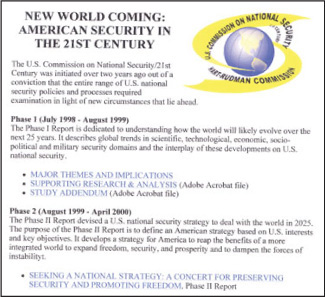
Ladies and gentleman, what the commission recommended was a return to a World War II-type GI Bill. A GI Bill in which—as Chairman Principi said—“veterans of our military could attend any school in America, limited only by their own aspirations, ability and initiative.”27
Also in 1999, another expert group called the United States Commission on National Security/21st Century and headed by former Senators Gary Hart and Warren Rudman, issued its report titled New World Coming: American Security in the 21st Century.28
The report also raised concerns about military recruiting by observing:29
Mr. Hart

Gary Hart
“Today, the military is having even greater difficulty recruiting quality people than the civilian sector of the government. Despite significant post-Cold War force reductions in recruiting goals, the services have missed their quotas in some recent years. Moreover, recruiting costs have risen by nearly one-third over the last four years….”
Mr. Montgomery
Here is the testimony of Admiral Tracey in 2000 before the Subcommittee on Benefits, House Committee on Veterans’ Affairs, then-chaired by Representative J.D. Hayworth of Arizona:30

Vice Admiral Patricia Tracey
“Money for college consistently ranks as the major reason young men and women give for enlisting….31 There is little doubt that the Montgomery GI Bill has met or even exceeded the expectations of its sponsors and has been a major contributor to the success of the All-Volunteer Force.
“The remarkably low unemployment rate, the booming economy, and the increasing propensity for high school seniors to enroll in college immediately upon graduation are such that we now face difficult challenges.”
Mr. Montgomery
Students, I would just note for you that “unemployment declined from 7.3 percent in 1992 to 4.7 percent in 1998; about 65 percent of high school graduates ages 18-19 now enroll in higher education.”32
Out of a universe of say, 100 17- to 21-year-old males, how many do you think the service branches get to recruit from? About 14, as of 2001.
The testimony of Lt. General Timothy Maude,33 U.S. Army, on May 24, 2001, is instructive:34
“… We believe that probably only 14 percent, or about 14 out of every 100, is our target audience when we go about our recruiting… after you eliminate those that are below the aptitude, the mental and moral disqualifications, those in jail, those already in the military, those in college, that leaves about 14 percent of the population, who meet those qualifications.”

Lastly, let’s cite the 2001 findings and recommendations of the U.S. Commission on National Security/21st Century35 in its report titled Road Map for National Security: Imperative for Change.
Co-chairman Hart, would you please share with our students the commission’s findings and recommendations regarding recruiting and an educational incentive?
Mr. Hart
“Thank you, Mr. Chairman.
“We must change the ways we recruit military personnel. This means putting greater effort into seeking out youth on college campuses and providing grants and scholarships for promising candidates.36
“Congress should significantly enhance the Montgomery GI Bill….
“The [Montgomery] GI Bill is both a strong recruitment tool and, more importantly, a valuable institutional reward for service to the nation….
“GI Bill entitlements should equal, at the very least, the median education costs of four year U.S. colleges, and should be indexed to keep pace with increases in those costs. Such a step would have the additional social utility of seeding veterans among the youth at elite colleges….”37

Mr. Montgomery
Students, I wanted you to know about the 1997-2001 findings and recommendations of each of these commissions. Their recommendations inspired enhancements to the Montgomery GI Bill, especially in light of the tragic events of September 11, 2001.
By 2003, the United States and its partner nations had liberated Iraq from its brutal dictator, Saddam Hussein.
I was so proud of our soldiers, sailors, airmen, Marines, and Coast Guardsmen who liberated Iraq. I think Nancy Gibbs of TIME Magazine said it best in her 2003 “Person of the Year” article:
Ms. Gibbs

Nancy Gibbs
“For uncommon skills and service, for the choices each one of them has made and the ones still ahead, for the challenge of defending not only our freedoms but those barely stirring half a world away, the American soldier is TIME’s ‘Person of the Year.’38

“They swept across Iraq and conquered it in 21 days. They stand on streets potholed with skepticism and rancor. They caught Saddam Hussein. They are the face of America, its might and good will, in a region unused to democracy.39
“To have pulled Saddam Hussein from his hole in the ground brings the possibility of pulling an entire country out of the dark.40
“… Our pilots and soldiers and sailors are, for starters, all volunteers, in contrast to most nations, which in 2003 conscript those who serve in their armed forces.41
“Liberty can’t be fired like a bullet into the hard ground. It requires, among other things, time and trust and a nation scarred by tyranny and divided by tribe and faith is not going to turn into Athens overnight.42
“It now falls to the Iraqis themselves to decide what they are willing and able to do with the chance they have been given, and the rest of the world to decide how to help.”43
Mr. Montgomery
Representatives Christopher Smith and Lane Evans will speak to enhancements they’ve championed to the Montgomery GI Bill from 2000 to 2005. The high-energy leadership of these two legislators on behalf of our fellow Americans who have worn the military uniform has been exceptional.
Mr. Smith

Christopher Smith
“We’ve each served in Congress for about 22 years. Lane offered the amendment at committee mark-up in 1987 to name the New GI Bill the ‘Montgomery GI Bill’ and I was a cosponsor with the chairman in 1981 when he introduced the New GI Bill legislation.
“We also had the good fortune to follow in Mr. Montgomery’s footsteps by serving as chairman and ranking Democratic member, respectively, of the House Veterans’ Affairs Committee from 2001-2004.”
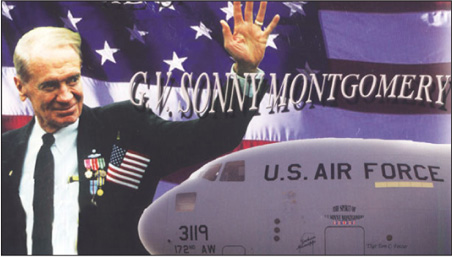
A C-17 transport plane named the “Spirit of Sonny Montgomery.”
Mr. Evans

Lane Evans
“As Chris and I see it, the Montgomery GI Bill and the spirit and vision of Sonny Montgomery indeed represent part of the continuing legacy of the World War II GI Bill—the law that works!
“We worked with Senate Veterans’ Affairs Committee Chairman Arlen Specter (R-PA) and Ranking Minority Members Jay Rockefeller (D-WV) (through 2002) and then Senator Bob Graham (D-FL) (through 2004), in making the Montgomery GI Bill even more comprehensive.
“On December 27, 2001, President George W. Bush signed into law H.R. 1291, the Veterans Education and Benefits Expansion Act of 2001. Public Law 107-103 boosted Montgomery GI Bill education benefits from $24,192 in December 2001 to $35, 460 in October 2003, an increase of $11, 268. This was the largest increase in the Montgomery GI Bill’s history. The Congressional Budget Office estimated the cost of these increases over 10 years at $6.8 billion.”44
Mr. Smith
“I was very grateful for President Bush’s support in signing H.R. 1291—and to Jim Nussle (R-IA) and John Spratt (D-SC), chairman and ranking member of the House Budget Committee.
“I met with Chairman Nussle at every opportunity; in his office, on the House floor, and seemingly each time I saw the chairman I made the empirical case for the 46-percent Montgomery GI Bill increase over three years embodied in H.R. 1291, which I introduced as a bipartisan measure.
“Chairman Nussle and Ranking Member Spratt included the bill’s ultimate $6.8 billion ‘direct spending’ increase in the House- and Senate-passed budget blueprint for FY 2002. Jim and I also discussed the inclusion of the Montgomery GI Bill increase in the budget blueprint in the colloquy on the House floor, as documented in the Congressional Record.
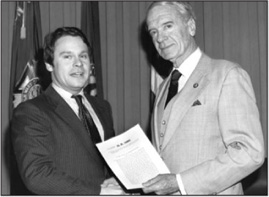
Rep. Chris Smith and Sonny in 1987.
“It would have been impossible for Lane, me and HVAC Subcommittee on Economic Opportunity Chairman Mike Simpson to have identified some $6.8 billion in offsets over 10 years to pay the bill.
“Nevertheless, From 2000-2004 alone, Congress enhanced the Montgomery GI Bill in six major areas, each time meeting pay-as-you-go requirements. Congress, for example:
• Accelerated Montgomery GI Bill benefits payments for high-cost, high-technology courses;45
• Protected against loss of Montgomery GI Bill benefits resulting from military mobilization or deployment;46
• Enabled use of the Montgomery GI Bill for entrepreneurship courses offered by U.S. Small Business Development Centers;47
• Enabled use of these benefits for occupational licensing and credentialing testing48; and
• Updated significantly the Montgomery GI Bill on-job training and apprenticeship benefits to reflect business and industry today, including competency standards.”49
Mr. Montgomery
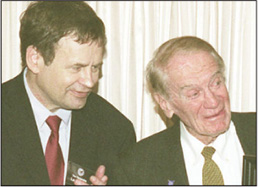
Sonny and Lane Evans in 2004.
Representative Smith has been a New GI Bill leader from the beginning. And I know of no member of Congress who has authored more improvements to the Montgomery GI Bill than former Marine, Representative Lane Evans.

Michael Michaud

Henry Brown
Hayworth (R-AZ), Mike Simpson (R-ID), Bob Filner (D-CA), Silvestre Reyes (D-TX), Henry Brown, Jr. (R-SC), and Michael Michaud (D-ME) all played leadership roles in improving selected aspects of the Montgomery GI Bill.50
As we continue to rely more and more on the Guard and Reserve, I think we need to make their education benefits more equal to our regular, active-duty military.
Let’s hear from Bob Norton, deputy director of government relations for the Military Officers Association of America and a principal in the Partnership for Veterans’ Education, a Washington-based organization made up of military personnel associations, veterans’ organizations, and higher education associations.
I’d note, too, that Mr. Larry Rhea, legislative director of the Non Commissioned Officers Association of the U.S.; Mr. Sid Daniels, legislative director of the Veterans of Foreign Wars of the U.S.; Mr. Don Sweeney, legislative director of the National Association of State Approving Agencies; and Dr. Steve Kime, president of the Servicemembers Opportunity Colleges, were among the principals in forming the Partnership for Veterans’ Education in 2000.
Mr. Norton

Bob Norton
“The father of the modern GI Bill named for him, Representative G.V. ‘Sonny’ Montgomery, long-time chairman of the House Veterans’ Affairs Committee, envisioned that Guard and Reserve men and women deserved to participate in the GI Bill program in exchange for their voluntary service. But at the time, there was ‘pushback’ on the issue of ‘veteran status’ for Reservists. Moreover, leaders then did not anticipate today’s routine usage of Guard and Reserve forces for active duty missions. Some groups felt that Reservists who had not served on active duty had not earned veterans (readjustment) benefits. Chairman Montgomery forged a compromise that resulted in placing the new Reserve GI Bill programs into the Armed Forces Code, Title 10….
“A new architecture is needed to align the Montgomery GI Bill with the realities of the Total Force policy in the 21st century.”51
A Partnership for Veterans’ Education member, the American Association of State Colleges and Universities, has assisted the partnership in its recommendations regarding a “Total Force” Montgomery GI Bill. Vice President for Governmental Relations Ed Elmendorf will give us some insight, then Mike McGrevey, former vice president of Mississippi State University.
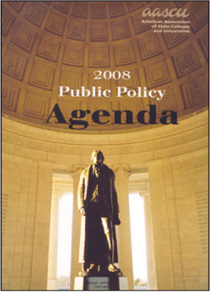
Mr. Elmendorf

Ed Elmendorf
“The AASCU supports amendments to the Montgomery GI Bill that would equalize the benefits for active and Reserve components, including to:52
• “Benchmark Montgomery GI Bill benefits to the cost of attendance at public four-year institutions;
• “Consolidate active duty and Reserve Montgomery GI Bill programs in Title 38, U.S. Code for Veterans Benefits, and align benefit rates with type and length of service (A “Total Force GI Bill”);
• “Close the growing benefit gap between Chapter 1606, Educational Assistance for Members of the Selected Reserve, in Title 10 and Chapter 30, Montgomery GI Bill-Active Duty, in Title 38;
• “Transfer Chapter 1607, the Reserve Educational Assistance Program (REAP), to Title 38, U.S. Code for Veterans Benefits, from Title 10 U.S. Code for [the] Armed Services, and adjust the rate formula to provide one month of active duty benefits under Chapter 30 for every month mobilized; and
• “Authorize the use of Reserve Montgomery GI Bill benefits earned during mobilization for a period of ten years after leaving the service—equal to current portability for active duty members.”
Mr. McGrevey

Mike McGrevey
“Mississippi State University student and Reservist Staff Sergeant Kimberly Island is an example of the Guard and Reserve members nationwide who would benefit from a “Total Force” Montgomery GI Bill. As Colonel Norton and Mr. Elmendorf have said, we need a new architecture to close the benefit gap between regular, active-duty service and Reserve service.

Kimberly Island
“There are rarely easy issues in the art of legislating during a 2008 Presidential election year when creating or adding to new entitlement benefits is involved.

“Legislating also is not easy when there are multiple ‘dimensions’ to a public policy issue. The Washington Times and USA Today 2008 editorials (previous page) raise dimensions of educational opportunity, politics, partisanship/bipartisanship, stagnant middle-class incomes, student debt, military recruitment and retention, national debt, dependent spouse and child transferability of benefits, and workforce development. Below, an editorial by George Lisicki, VFW National Commander, speaks to the issues.
“Do you see other ‘dimensions’ to this debate as well?
“When Congress passes legislation to change the Montgomery GI Bill, veterans can go to www.gibill.va.gov to get information or refer to booklets produced by the VA as well.
“For all veterans’ benefits, publications like For Service to Your Country are helpful.
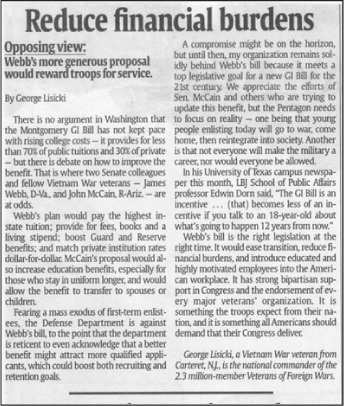
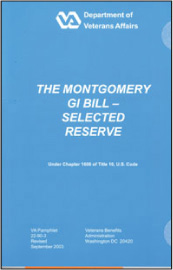
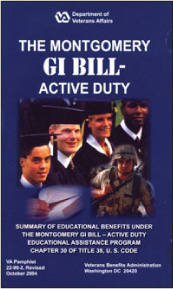

George Lisicki, VFW National Commander
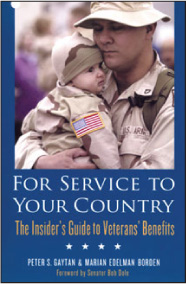
Mr. McGrevey
“H.R. 2642, the Iraq Supplemental Appropriations Act, that President George Bush signed into law June 30, 2008, (Public Law 110-252) both increased the Montgomery GI Bill to $1,321 per month, and established a generous, new ‘Post-9-11 GI Bill’ for persons who enlist after August 1, 2009.
“Senators Jim Webb (D-VA) and Chuck Hagel (R-NE) furnished the bipartisan leadership for the improvements, which were derived from an amended version of S. 22, the proposed Post-9-11 Veterans Education Assistance Act, that they—and 37 other Senators—initially introduced January 4, 2007.
“Happily, Senators Webb and Hagel included two provisions in the Post 9-11 GI Bill that Chairman Montgomery and his colleagues originally introduced in H.R. 1400, the proposed Veterans’ Educational Assistance Act of 1981 we have discussed in earlier chapters. One of these provision no longer requires new enlistees to pay in $1, 200 to be eligible for the Post 9-11 GI Bill. The other provision allows the service member to transfer GI Bill benefits to a spouse or a child.
“Indeed, President Bush called for the ‘transferability’ provision in his January 28, 2008, State of the Union Address. I’d note, too, that former Senator Max Cleland (D-GA) had been a longstanding advocate for the provision.
“Even though Congress created a new Post 9-11 GI Bill, Congress did not repeal the Montgomery GI Bill for new enlistees or those service members and veterans already eligible.”

Marine recruits training at Parris Island, SC, in 2009.
A law that works can always work better. Coupled with other factors, since 1987 the youth of America has responded to an improved Montgomery GI Bill educational incentive, as we thought they would.
And the Montgomery GI Bill served as the economic investment that we thought would help service members transition to civilian life. Indeed, it has accomplished what its statutory purpose clauses said it should do.53
More pointedly, who would have thought that in 2008—27 years after we introduced our original New GI Bill legislation (H.R. 1400 in 1981)—that the new, 2008 Post 9-11 GI Bill enacted into law would contain two provisions from H.R. 1400 that the Senate continuously opposed? These two provisions were (1) no $1,200 pay reduction to gain eligibility, and (2) “transferability” of the benefit to the service member’s spouse or child.54
WHAT’S NEXT
In Chapter 16 we look at the role of the Montgomery GI Bill in developing America’s workforce to help the United States compete in a world economy.